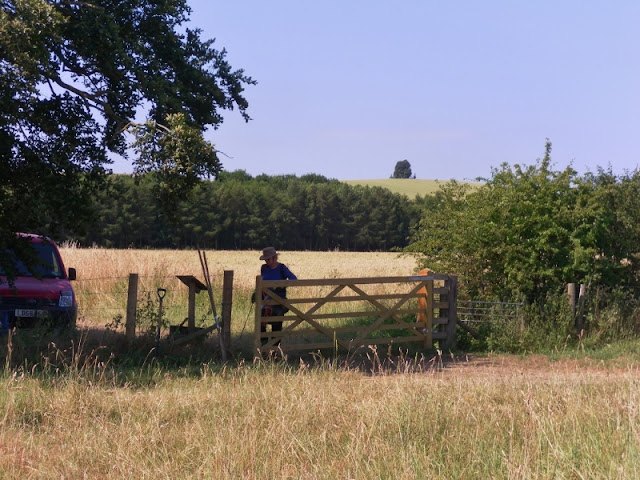By the Session Leader:
Another summer’s day, another thistle-bash. This time in an actual wildflower meadow, so
plenty of pretty flowers which were not targets for clearance:
Not many wild roses among them, but plenty
of purple-headed knapweed. Knapweed has
similar flowers to a thistle, but it was only the plants with barbs we
were taking out.
Tools used depended very much on
personal preference of volunteers. The
choice was between: scythe; dassel-basher; lazy-dog; or just gloved hands. [I prefer a lazy swipe with a sharp scythe-blade
myself, rather than lazy-dogging. – Ed.]
Some Green-Gymmers went back to ‘HQ’ for a change of tool after a while:
The location is part of the River of Life project. As can be seen from the inlets cut from the
nearby River Thames, and their distinctive riparian vegetation:
Despite traffic-noise borne on the breeze
(hence no field recordings of skylark), it was often hard to remember how close
we were to a main road:
To get to the site, we ourselves had travelled
along a single-track lane, which had gradually become less and less of a
serious road. Though we did
not experience anything like the same degree of difference of opinion between
humans and other species as to who is supposed to be on a road, as is perfectly
normal in some parts of the world; eg, people on wheels meet cow in middle of road (guess who comes off best) in one video
currently doing the rounds on the internet, said to be filmed ‘in Altai Region’.
Location of that clip, incidentally, would
appear to be Altai Autonomous Republic (Chemalsky/Chamal District) rather than Altai
Krai. In which case the road must, I think, be the
M-52, because there is (or used to be) only one highway in the whole of Altai AR. That cattle frequently stray on to it, is
indeed a routine driving hazard:
 | |||||
| M-52, east of Chike Taman Pass: not the sleek, well-fed cattle of European zone of Altai AR. | Photo taken 2008 |
As for the cattle we were merely sharing a field
with this morning, at first they were more interested in behaving like water
buffalo. Then they appeared torn between
wanting to move to shade, and to watch what the strange new human in their life
was up to:
Wildlife spotted this morning included: two
heron; a pair of partridges inadvertently flushed from cover of the long grass
(? Grey Partridge – striking reddish tail feathers); a kestrel going about its
business while we were enjoying a tea-break in the shade; and “a caterpillar
tree” – what had been a flourishing ragwort plant, covered in what will be cinnabar
moths:
[Which
I didn’t recognize at first: they did not look the striking black and yellow I
have seen before. Then I remembered I
was wearing sunglasses. – Ed.]
Now if the Cinnabar Moth (Tyria Jacobaeae) were doing a little better as a species in
this country, we would not have so much ragwort to clear before it seeds! And then we could concentrate purely on thistles.
As it was, naturally that particular sad
specimen of ragwort we left well alone, and just took out others of its flourishing
yellow-flowered companions as we came across them while hunting thistles.








No comments:
Post a Comment